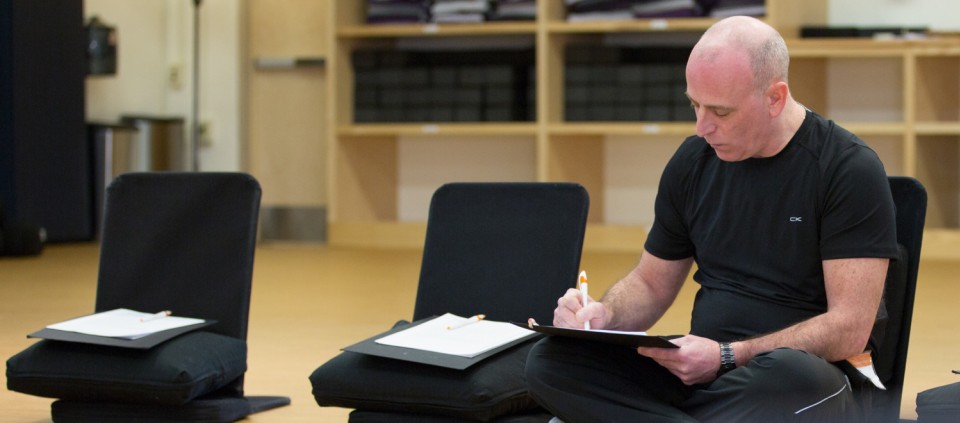Writing, Meditation, and the Stories We Tell Ourselves, with Ethan Nichtern

In this edition of the StoryFlow series, best-selling author and Buddhist teacher Ethan Nichtern talks to his old friend and literary agent/consultant, Kripalu presenter Lisa Weinert, about meditation, writing, and spiritual healing. Ethan has been writing and meditating since he was six years old. His latest book, The Dharma of the Princess Bride, is a personal look at relationships through the lens of Buddhism and Rob Reiner's classic film. Read an excerpt.
Lisa In our program on narrative medicine at Kripalu, we explore the healing relationship between spirituality and creativity. You have been walking both paths your entire life. Tell me about your path, as a writer and a spiritual being.
Ethan The notion of the connection between contemplative practices and creative expression was always automatic and prominent in my upbringing. I knew I wanted to be a writer since I was in sixth grade and I was working on some fantasy short story. Both my parents came from very creative backgrounds, and Chögyam Trungpa (my parents’ longtime teacher and the founder of Shambhala) was also an accomplished artist—he wrote a lot of poetry. This relationship is actually a big part of the Shambhala teachings. Chögyam thought that culture was the context in which anybody’s spiritual or psychological life unfolded. So, to understand that and to be able to actually create a helpful and healing cultural context can be huge parts of how we understand our experience.
How do you see the role of narrative in your teachings as a Buddhist and meditation teacher?
So much of the teachings of Buddhist psychology talk about narrative. We are often trapped in recurring narratives and storylines about our experience and they frame our perspective on the mind. To be able to work with narrative and to be able to shift it using contemplative practices and narrative practices is healing. In some ways, the stories we tell ourselves are the most entrapping part of our experience. At the same time, if we access them and express ourselves there’s possibility for connection and a shift.
A lot of times, we’re not aware of the narratives we tell ourselves. Through long-term practice, we see our habitual ways of thinking and seeing. This a great starting point, and from there we learn how to work with it in a flexible manner.
What is your personal writing and meditation practice?
I do both every day. Awareness and then some kind of shift is what a creative practice is all about. The view of my tradition is that you’re always meditating. Your mind is always working with some experience—you can be meditating on your breath, on compassion, on contemplation of what would I like to write next. Or the snarky e-mail you just received. Our mind is always placing itself on some object of attention.
When I’m working on a serious project, like writing a book, I will usually arrange writing as a series of loose practice sessions. I sit down and say a brief aspirational chant and light a stick of incense, and I don’t allow myself to leave the room until the incense is gone. At the end, I dedicating the merits of the practice, which means to imagine offering any benefit from the practice session to your own further development as well as to helping others. That helps me to view the writing as a similar practice as meditation.
There’s a famous Dorothy Parker quote, “I hate writing. I love having written.” What’s your experience of writing?
Writing is very personal. Writing is brutal—you’re really digging in there. If we create our own spiritual ceremony, it brings a safe and supportive structure to something that’s hard to do. The ceremony creates a container for this raw experience.
Meditation is the awareness aspect of the mind and writing is the expressive aspect of the mind. Either way, you are working with the mind—and we are not very good friends with our mind a lot of the time. So it’s brutal sometimes. Writing can have a really painful quality because it’s irritating to watch your own mind work.
Yikes! What’s the upside to this?
The upside is a feeling that I’ve been willing to go through that process of expression, whether or not something has been clarified or expressed beautifully. At least I’ve tried! There are moments when you feel like you’ve actually clarified something. If you’re lucky enough to share your work with others, you have the benefit of connection. It’s kind of a miracle to share your mind, a miracle that each of us has our own experience that’s impossible to describe—language is only an approximation—but we figure out a way to express it in a narrative flow and we pass it along to someone else and they take our language and it connects to their direct experience. That translation and direct experience is really miraculous.
Your book is called The Dharma of the Princess Bride. Why did you choose this subject?
The Princess Bride is a great example of spiritual healing in our age, because it’s a completely deconstructed fairy tale. A lot of times, when people deconstruct narrative, it heads towards apathy or cynical nihilism. However, the point of Buddhism is to deconstruct myths and narratives, so you can be more present and fulfilled, so you can be more loving and optimistic. The whole point of The Princess Bride is a deconstruction in the name of true love. In so many senses, pop culture has become our spiritual text.
Find out about upcoming programs with Ethan Nichtern and Lisa Weinert.
© Kripalu Center for Yoga & Health. All rights reserved. To request permission to reprint, please e-mail editor@kripalu.org.
Lisa Weinert, RYT-200, is a yoga teacher, storyteller, and author of Narrative Healing: Awaken the Power of Your Story.
Full Bio and Programs